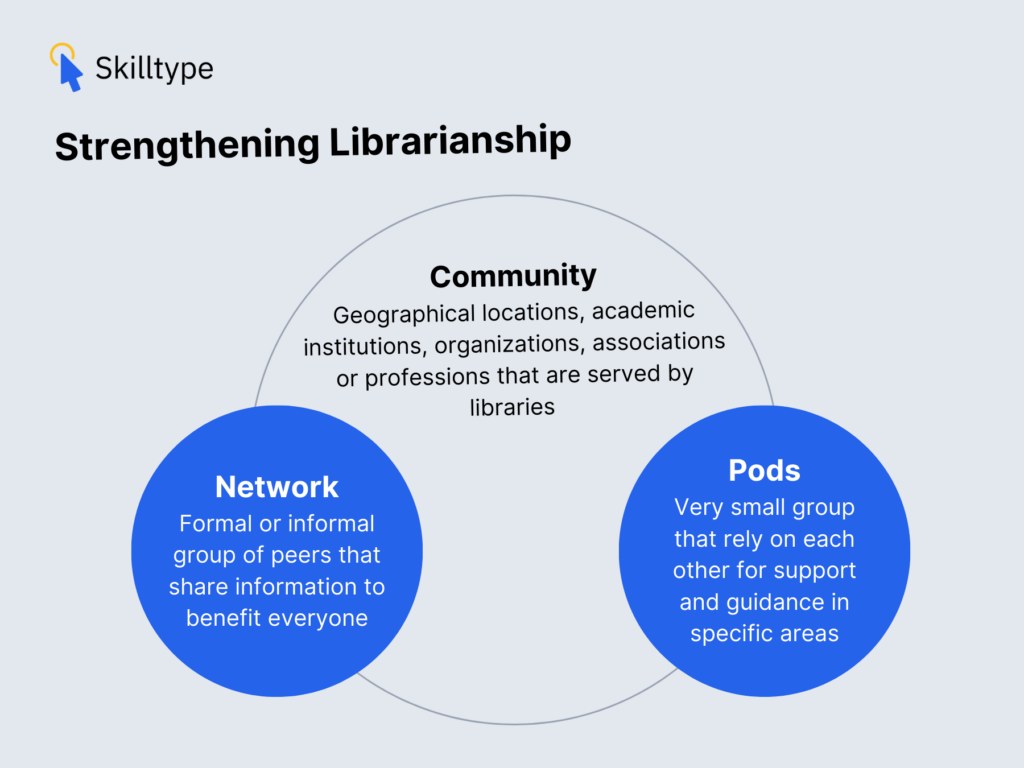
Creating community
What does “creating community” mean? How can someone be an “expert” at creating community? I asked myself this question as I read the announcement that I had joined Skilltype, and wondered how else I could describe what I love doing, what I’m good at doing, and why I feel it is so important, especially in the field of librarianship.
As librarians, we serve a community, indicated by geographical locations, academic institutions, or organizations. We may also be part of peer-communities, in the form of associations, type of library work (public, academic, special), and listservs. Sometimes, especially for large communities, the community really only exists through formal structures, and there’s very little relationship-building or connection happening, only an identity label that indicates whether one belongs or does not.
Building your network
So how do we make the idea of community more meaningful? The answer is through networks, both formal and informal. These are groups of peers who voluntarily share information to benefit everyone as an individual, the group, and the affiliated institution of the individual. Networks are built around shared interests; for example, an association committee, like the Asian Pacific American Library Associsiation (APALA) Mentoring Committee, which I am a member of, actively working to do something (manage the annual mentoring program) together. Another example from one of my networks is the Professional Development Alliance of Library Consortia (PDA), a group of consortial staff who meet regularly to share programming and brainstorm ideas for collaborative programs. Cross-collaboration between institutions happens organically as the result of relationships developed through the network.
Networks are much smaller than a community, and transcend community identity. Individuals require a certain level of trust and a deeper relationship with one another. These are the meetings you want to go to, the people you want to talk to.
The essence of pods in librarianship
What makes me stay connected, grounded, and excited about my work and librarianship are my pods, a term borrowed from the Bay Area Transformative Justice Collective, which describes very small groups who rely on each other for support and guidance in very specific areas. These pods cultivate deep, reciprocal relationships in certain areas of work, which develop into trusted friendships. One may have any number of pods, but each is distinct from the other in purpose. For instance, there is a pod I reach out to if I’m struggling with a project, and a different pod if I am struggling with a relationship. These pods generally sprout from networks, and enhance the continued value of the work required to maintain active networks. Pods are increasingly important for librarians to safeguard our mental health while facing extremely stressful situations related to our workplaces or the current political climate.
Librarianship, built on sharing information and resources, excels in creating strong community, network, and pod relationships. That our field generally operates alongside rather than within the existing capitalist economy means that we are and can be encouraged to be more collaborative, generous with our time and energy, and prioritize relationships and collaborative learning than any other profession. As a whole, we tend to give much of ourselves to our profession and communities. In order to continue doing this successfully, it is important to have strong connections to serve as our air masks in case of the sudden loss of oxygen in the cabin!

Navigating my journey with Skilltype
As I transition from a Skilltype user to the end of my first month in a staff role, I have been examining the ways the platform already supports community and network, and determining what needs to be developed in order to better foster connection and collaboration with others. My first step will be to create networks of interest, such as Cataloging, Open Access, User Experience, which will be an option for everyone who indicates an interest in these areas. Starting with a couple of test spaces, I’ll explore how to develop these groups into networks that communicate and collaborate. Our goal is to offer an easy starting point with Skilltype and ensure continued involvement, allowing members to learn, connect, and gain professional enrichment from the experience

Talk to me
To do my job well, I need to learn from you. I need to hear how you are using Skilltype, or how you want to be using Skilltype. I want to get to know you. Why are you in this profession? What do you want your career to look like? Which networks do you want to join?
I’m here for you. Literally, that’s my job – to meet, talk with, listen to Skilltype members – please do not hesitate to reach out so we can set up some time to meet and chat.
Three ways to reach me:
Office hours – on Zoom, every Wednesday from 12 -1 pm CT
Schedule a meeting with me – you pick the date/time